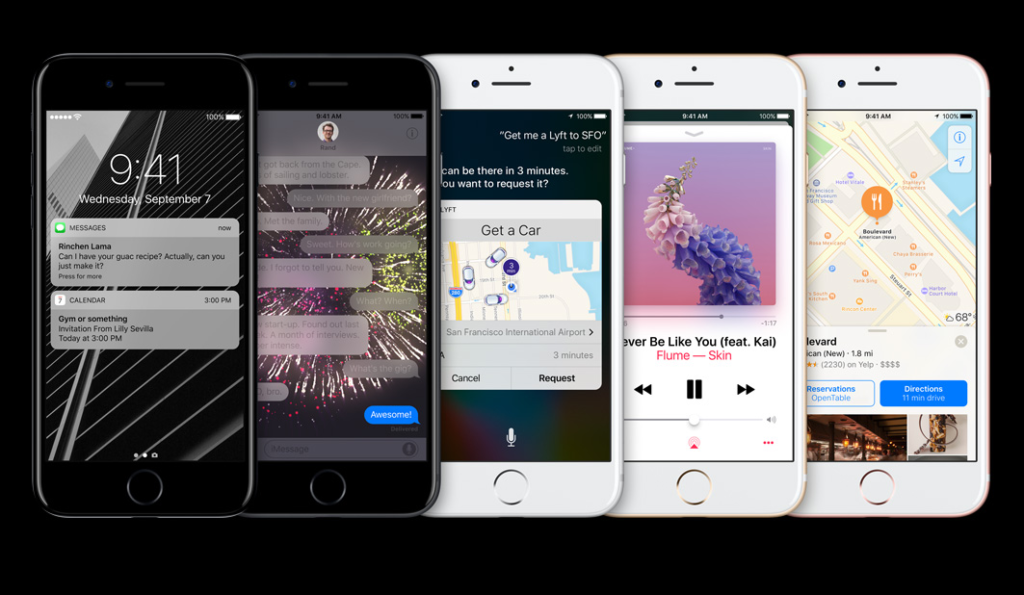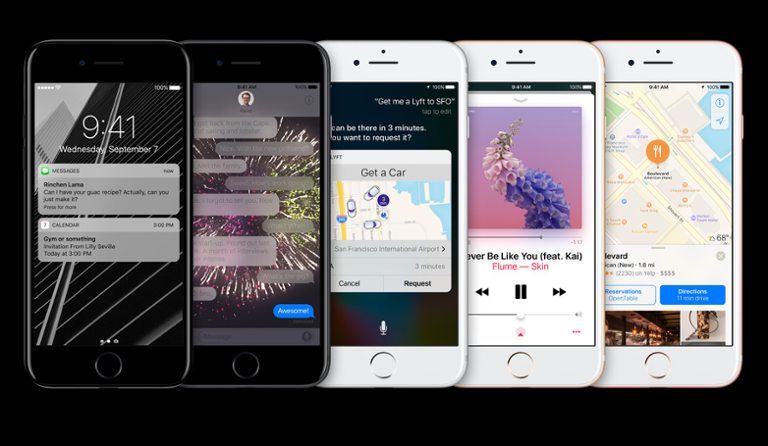 Apple executives took to a San Francisco stage Sept. 7 to unveil the iPhone 7, along with an updated Apple Watch and assorted accessories. As widely rumored, Apple killed the headphone jack in its latest smartphone, while increasing the minimum onboard storage to 32GB. But otherwise, the event offered little that was truly groundbreaking—unless you count waterproofing as a revolutionary advance. Back in ye olden days of five-plus years ago, Apple and its rivals would regularly offer up new form-factors with never-before-seen hardware. Although Apple revealed one new product during this event—the wireless AirPods, seemingly built in large part to compensate for the iPhone 7’s lack of a headphone jack—it mostly focused on updates to current equipment: boosted cameras, improved processors, brighter screens, and so on. Has the iPhone reached a plateau in its hardware evolution? Maybe. If the device has settled into a pattern of iterative upgrades for the foreseeable future (announced by executive presentations in which that progress is positioned as unprecedented innovation), it could mean a struggle on Apple’s part to convince users to upgrade to the Next Big Thing on an annual basis. For developers, however, iterative upgrades mean more stability, and the chance to build apps without worrying that radical changes to the underlying hardware are right around the corner. At the beginning of Apple’s event, Nintendo developer Shigeru Miyamoto stepped onstage to reveal that “Super Mario Bros” would finally arrive on iOS in time for the holidays. In gaming and mobile-device circles, this is a very big deal: for years, pundits and critics have argued that Nintendo should port its beloved characters onto smartphones. While the unveiling of an iPhone is always a big deal in tech circles, the Mario announcement generated its own share of press. In the early days of the iPhone, the idea of an app or game equaling the hardware announcement would have been inconceivable. But now we’ve perhaps reached the stage where the iPhone begins to fade into the background, and the apps and software take an even more prominent role. That’s good news for developers. Time will tell whether it’s good news for Apple.
Apple executives took to a San Francisco stage Sept. 7 to unveil the iPhone 7, along with an updated Apple Watch and assorted accessories. As widely rumored, Apple killed the headphone jack in its latest smartphone, while increasing the minimum onboard storage to 32GB. But otherwise, the event offered little that was truly groundbreaking—unless you count waterproofing as a revolutionary advance. Back in ye olden days of five-plus years ago, Apple and its rivals would regularly offer up new form-factors with never-before-seen hardware. Although Apple revealed one new product during this event—the wireless AirPods, seemingly built in large part to compensate for the iPhone 7’s lack of a headphone jack—it mostly focused on updates to current equipment: boosted cameras, improved processors, brighter screens, and so on. Has the iPhone reached a plateau in its hardware evolution? Maybe. If the device has settled into a pattern of iterative upgrades for the foreseeable future (announced by executive presentations in which that progress is positioned as unprecedented innovation), it could mean a struggle on Apple’s part to convince users to upgrade to the Next Big Thing on an annual basis. For developers, however, iterative upgrades mean more stability, and the chance to build apps without worrying that radical changes to the underlying hardware are right around the corner. At the beginning of Apple’s event, Nintendo developer Shigeru Miyamoto stepped onstage to reveal that “Super Mario Bros” would finally arrive on iOS in time for the holidays. In gaming and mobile-device circles, this is a very big deal: for years, pundits and critics have argued that Nintendo should port its beloved characters onto smartphones. While the unveiling of an iPhone is always a big deal in tech circles, the Mario announcement generated its own share of press. In the early days of the iPhone, the idea of an app or game equaling the hardware announcement would have been inconceivable. But now we’ve perhaps reached the stage where the iPhone begins to fade into the background, and the apps and software take an even more prominent role. That’s good news for developers. Time will tell whether it’s good news for Apple. iPhone 7 Kicks Off New Phase for Apple
 Apple executives took to a San Francisco stage Sept. 7 to unveil the iPhone 7, along with an updated Apple Watch and assorted accessories. As widely rumored, Apple killed the headphone jack in its latest smartphone, while increasing the minimum onboard storage to 32GB. But otherwise, the event offered little that was truly groundbreaking—unless you count waterproofing as a revolutionary advance. Back in ye olden days of five-plus years ago, Apple and its rivals would regularly offer up new form-factors with never-before-seen hardware. Although Apple revealed one new product during this event—the wireless AirPods, seemingly built in large part to compensate for the iPhone 7’s lack of a headphone jack—it mostly focused on updates to current equipment: boosted cameras, improved processors, brighter screens, and so on. Has the iPhone reached a plateau in its hardware evolution? Maybe. If the device has settled into a pattern of iterative upgrades for the foreseeable future (announced by executive presentations in which that progress is positioned as unprecedented innovation), it could mean a struggle on Apple’s part to convince users to upgrade to the Next Big Thing on an annual basis. For developers, however, iterative upgrades mean more stability, and the chance to build apps without worrying that radical changes to the underlying hardware are right around the corner. At the beginning of Apple’s event, Nintendo developer Shigeru Miyamoto stepped onstage to reveal that “Super Mario Bros” would finally arrive on iOS in time for the holidays. In gaming and mobile-device circles, this is a very big deal: for years, pundits and critics have argued that Nintendo should port its beloved characters onto smartphones. While the unveiling of an iPhone is always a big deal in tech circles, the Mario announcement generated its own share of press. In the early days of the iPhone, the idea of an app or game equaling the hardware announcement would have been inconceivable. But now we’ve perhaps reached the stage where the iPhone begins to fade into the background, and the apps and software take an even more prominent role. That’s good news for developers. Time will tell whether it’s good news for Apple.
Apple executives took to a San Francisco stage Sept. 7 to unveil the iPhone 7, along with an updated Apple Watch and assorted accessories. As widely rumored, Apple killed the headphone jack in its latest smartphone, while increasing the minimum onboard storage to 32GB. But otherwise, the event offered little that was truly groundbreaking—unless you count waterproofing as a revolutionary advance. Back in ye olden days of five-plus years ago, Apple and its rivals would regularly offer up new form-factors with never-before-seen hardware. Although Apple revealed one new product during this event—the wireless AirPods, seemingly built in large part to compensate for the iPhone 7’s lack of a headphone jack—it mostly focused on updates to current equipment: boosted cameras, improved processors, brighter screens, and so on. Has the iPhone reached a plateau in its hardware evolution? Maybe. If the device has settled into a pattern of iterative upgrades for the foreseeable future (announced by executive presentations in which that progress is positioned as unprecedented innovation), it could mean a struggle on Apple’s part to convince users to upgrade to the Next Big Thing on an annual basis. For developers, however, iterative upgrades mean more stability, and the chance to build apps without worrying that radical changes to the underlying hardware are right around the corner. At the beginning of Apple’s event, Nintendo developer Shigeru Miyamoto stepped onstage to reveal that “Super Mario Bros” would finally arrive on iOS in time for the holidays. In gaming and mobile-device circles, this is a very big deal: for years, pundits and critics have argued that Nintendo should port its beloved characters onto smartphones. While the unveiling of an iPhone is always a big deal in tech circles, the Mario announcement generated its own share of press. In the early days of the iPhone, the idea of an app or game equaling the hardware announcement would have been inconceivable. But now we’ve perhaps reached the stage where the iPhone begins to fade into the background, and the apps and software take an even more prominent role. That’s good news for developers. Time will tell whether it’s good news for Apple. 


